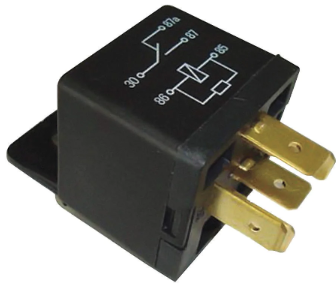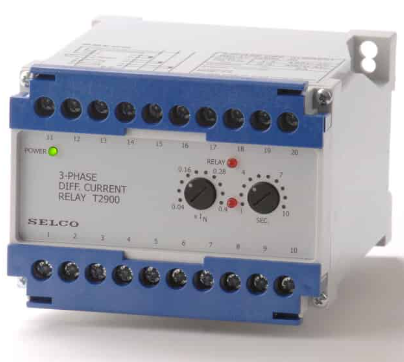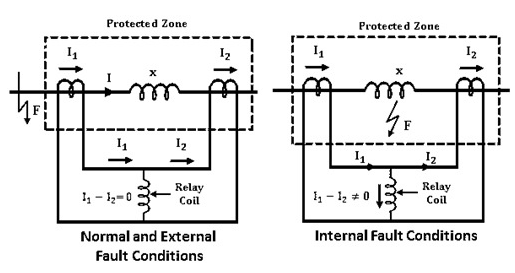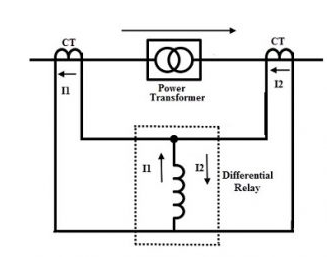Differential Relay : Circuit, Working, and Applications
Overview of relay
One form of switch used to use a signal to turn a high current and high voltage based device ON or OFF is a relay. Different types of relays, including latching, reed, solid state, automotive, timer delay, differential relay, etc., are categorized. Different types of relays are employed in power system protection, but a differential relay is one of them that is usually used to protect a transformer and a generator from localized failures. The faults that happened within the protection zone are very sensitive to this relay, whereas faults that occurred outside of the protection zone are less responsive. A differential relay's interaction with applications is briefly discussed in this article.

Overview of Differential Relay
A differential relay is one that activates after the phasor difference for at least two of the identical electrical quantities surpasses a predetermined threshold. Most relays typically operate when a quantity exceeds a certain limit, however this particular relay operates based on the difference between two or more identical electrical amounts.
A differential relay's job is to protect equipment in a fast, sensitive, and naturally selected manner. Due to the turn-to-turn winding problems' tiny growth in generated current, which remains below the relay's pickup sensitivity, these relays will not offer safety to machines and transformers. If you want to get more information and products about the relays, you can look at this Electronic Components Platform.

Working Principle of a Differential Relay
A differential relay compares the phase angle and the magnitudes of two or more identical electrical values. It is relatively easy to use and works well to compare these two electrical variables within a circuit using a differential relay. In contrast to the incoming and departing current in a line, for instance, if a significant amount of current flows through the protected line relative to the amount of current leaving from it, then more current must supply within the fault. In order to separate the circuit, a relay can be controlled by the difference between the two electrical variables.
The relay won't function under normal operating circumstances since the entering and departing currents are equal in phase and magnitude. However, these current flows will no longer be equal in phase and magnitude if a systemic malfunction develops. This type of relay is employed in such a way that the operational coils get the difference in entering and departing current. In fault situations, the relay coil can therefore be activated due to the variable current flow. As a result, this relay operates and activates the circuit breaker to trip the circuit.
Two current transformers are connected to any face of the power transformer in the differential relay circuit shown above, with one CT being connected to the main side and the other to the secondary side of the PT (power transformer). Simply said, this relay compares the direction of current on either side. This relay is prone to operating if there is any imbalance in the circuit's current flow. These relays might be biased differential, current differential, or voltage balancing relays.
Relay for Current Balance Differential
This differential relay operates whenever a fault occurs in the protected area, causing a change in the entering and departing current of that area. We can therefore identify the fault within the protected region by comparing these currents, either in phase or magnitude or in both. This relay checks the two currents and delivers a trip signal to the CB if the difference is more than a certain value (circuit breaker). The following diagram shows the connections for the differential relay protection circuit under normal conditions, external faults, and internal faults, respectively.

At each end of the part that has to be protected, the two CTs in the circuit mentioned above are used. The relay coil is simply linked between the two CTs in the equipotential position, preventing any normal current flow through the coil. so that relay malfunction can be prevented. The flow of current into the protected zone is equal to the flow of current away from the protected region in normal and external fault circumstances from the above circuit (I1 - I2 = 0). As a result, there won't be any current flowing through the relay coil. Therefore, it is still not in use.
The flow of current into the protected region is different from the flow of current exiting it in an internal fault condition, as seen in the above figure (I1 - I2 0). Therefore, the operating coil of the relay is fed with these current flow differences, which are known as the circulating current, and the relay operates if the operating torque is greater than the restraining torque.
Advantages of differential relay
- A 16-bit microprocessor is totally capable of handling digital signals.
- The power system's most important protection is found here.
- The adoption of a precise 16-bit analog-to-digital conversion technique ensures exceptional measurement accuracy over the whole range of settings.
- These are incredibly easy to adapt to various alarm and substation systems.
- Due to the fact that they cannot distinguish between minor defects and big loads, these relays are exceptionally sensitive.
- These relays prevent network failures.
Disadvantages of differential relay
- The pilot cable's capacitance will compromise the accuracy of the current differential relay during periods of high current flow.
- Due to pilot cable impedances and construction flaws, the current transformers in this relay cannot have comparable properties or ratings. As a result, a relay will operate improperly as a result.
- To establish the ideal balance between CTs, the building of a voltage balancing type relay becomes complicated.
- Shorter-length lines can use this relay's protection with success.
Applications of differential relay
- This relay is widely used to safeguard transformers and generators from localized disturbances.
- These relays are often employed primarily to shield the machinery from internal defects. In order to protect the stator winding of the alternator from internal problems, Merz price protection is one sort of differential relay.
- The winding of a transformer is safeguarded by this type of relay.
- These are ideal for protecting small objects as well as the many components of the power system, such as bus bars, generators, reactors, transmission lines, transformers, feeders, etc.





